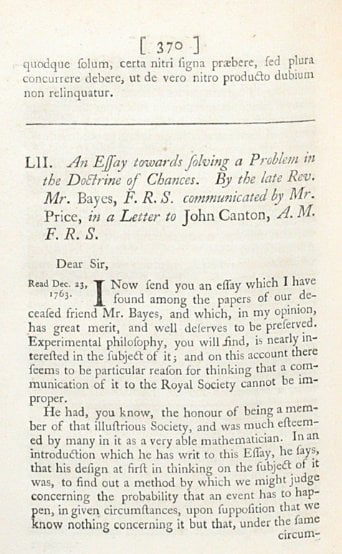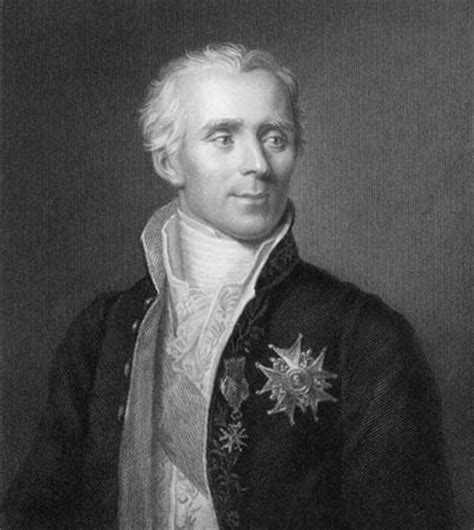- Naive Bayes Classifier History
- 29 July 2020
- by HolyPython
Bayes, Price and Laplace
Nonconformist church minister to legendary statistician

Thomas Bayes
Thomas Bayes is the guy who founded Bayes theorem which Naive Bayes Classifier is based on.
Bayes lived in England between 1701 and 1761 and Bayes Theorem became very famous only after his death.
He was born in Hertfordshire and attended University of Edinburgh between 1719 and 1722 where he studied logic and theology.
After moving to Kent in 1734, he carried on his family tradition of nonconformism and worked as the minister of Mount Sion Chapel until 1752.
He is known to have published only 2 papers in his 30s, of which, one is in theology field and the other in mathematics.
1- Divine Benevolence, or an Attempt to Prove That the Principal End of the Divine Providence and Government is the Happiness of His Creatures (1731)
2- An Introduction to the Doctrine of Fluxions, and a Defence of the Mathematicians Against the Objections of the Author of The Analyst (published anonymously in 1736), in which he defended the logical foundation of Isaac
He continued to live a modest life as a Presbyterian minister.

If his friend Richard Price hadn’t gathered and published his work on probability after his death we could have missed on this significant discovery. However, there are many speculations that might make you think differently. Read on for the disputes!
Here is the original paper for Bayes’ Theorem:
Also there is a very nice summary and history of Bayes Theorem on Royal Statistical Society of Belgium by Thomas Bruss from Brussels here.
Bayes and beyond
So after Bayes passed away his friend Richard Price took his ideas very seriously and made significant contributions to edit, correct, connect the dots, elaborate, prepare and publish Bayes’ work: “An Essay towards solving a Problem in the Doctrine of Chances” in 1763.
This started a new phenomenon regarding: “How to compute a distribution for binomial distribution’s probability parameter”.
Price has been highly praised for his effort and contribution on Bayes’ legacy and some people even think that it should be regarded as Bayes-Price Theorem. Considering his significant contributions it makes sense actually but that brings us to another phenomenon: “First Impression Theory” (not sure if that exists.)
So! So far we have Bayes and Price have been doing amazing work in probabilistic statistics.
Read on to discover about the Frenchman that really advanced Bayes’ Theorem.
By the way, although they sound very similar theorem and theory mean different things:
Theorem is a result proven by axioms (mathematical logic or laws that are universally accepted as truth)
Theory is an explanation or statement that’s verifiable but yet to be proven (or can’t be proven in the short time-span of civilization so far.)

Pierre-Simon Laplace
Pierre-Simon Laplace is a Parisian, born in Normandy 48 years after Thomas Bayes (1749). Among countless other contributions such as: Laplace’s Equation, Laplace Transform, one of the first scientists to point out black holes and gravitational collapse etc. he also developed Bayesian probability.
We don’t have proof but given the geographical proximity between London and Paris and socio-cultural connections between British and French something tells me he might have at least heard about Bayes’ theorem.
Since Laplace’s 1812 paper “Théorie analytique des probabilités” we came a long way.
In 1980s Bayesian probability rose to a new level of fame with Markov chain Monte Carlo methods followed by increased interest and practice in applied statistics in financial markets, medicine, sociology, technology, economics, manufacturing and other fields.
Today, Bayes probability continues to have a huge place in applications through Machine Learning and Naive Bayes Classification particularly represents the core fundamentals of Bayes probabilistics.
You can find a very authentic copy of Laplace’s phenomenal 1812 paper: “Théorie analytique des probabilités” in its original language French here.

Finishing Thoughts
So what do you think? Was Thomas Bayes really the first guy to come up with the idea? After all, it’s hard to pinpoint old discoveries since there weren’t cameras, blogging, live streams or Twitter. Sometimes it comes to: who first published or elaborate a certain invention or idea.
In this case Bayes seems to be a somewhat clear inventor of Bayes Theorem but if it wasn’t for Richard Price his discoveries could be buried with him as incomplete thoughts.
Do you think Richard Price deserves an equal spot in history’s Walk of Fame? Or do you think it doesn’t even matter that much?
How about Frenchman Laplace though? This guy literally took Bayes Thorem which was demonstrated in a tiny perspective with data from Bernoulli trials, and made it a mainstream phenomenon giving birth to Bayesian Probability.
Laplace went on to apply Bayesian Probability in many different fields such as: Astronomy, Oceanography, Medical Statistics, Fluid Dynamics, Law Theory, Geometry, Mathematics and Statistics.
Laplace, a brilliant mind, has indeed left a mark in history with his discoveries and is sometimes referred to as French Newton.
